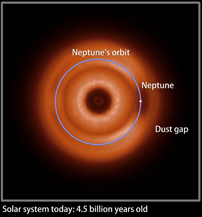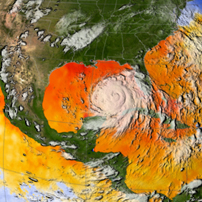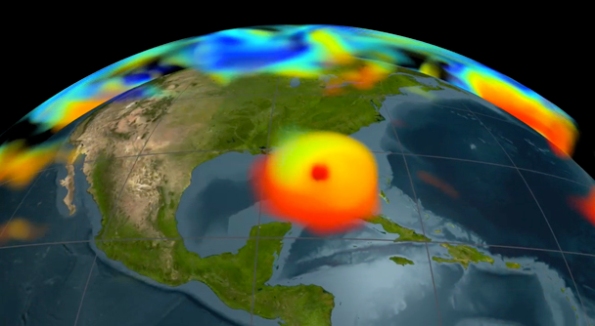Archive
Breaking the speed limit of supercomputing: Goddard computer network engineers demonstrate the data superhighway of the future
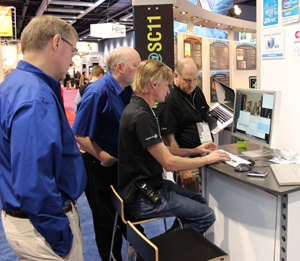
Goddard network engineers (in blue) Paul Lang (left) and Bill Fink (right) work with collaborators on high-speed data transfer demo at SC11.
Across the hall from me, in a large, loud computer equipment room humming with fans and trilling with transistors, is a gadget about the size of a small paperback — network engineers call them “pluggables.” These devices can pump data into a fiber optic line at rates up to 100 gigabits per second (100 Gbps).
That’s “gigabit” as in “a billion bits.” It is 10,000 times faster than a typical broadband cable modem connection (which operates at a mere 10 million bits per second, or 10 Mbps). 100 Gbps is fast enough to transfer a 25-gigabyte Blu-ray (HD) movie over the Internet in 2 seconds flat. Read more…
Breaking the speed limit of supercomputing: Goddard computer network engineers demonstrate the data superhighway of the future

Goddard network engineers (in blue) Paul Lang (left) and Bill Fink (right) work with collaborators on high-speed data transfer demo at SC11.
In a large, loud computer equipment room at NASA’s Goddard Space Flight Center, amidst the humming of fans and trilling of transistors, is a gadget about the size of a small paperback. Network engineers call them “pluggables.” These devices can pump data into a fiber optic line at rates up to 100 gigabits per second (100 Gbps).
That’s “gigabit” as in “a billion bits.” It is 10,000 times faster than a typical broadband cable modem connection, which operates at a mere 10 million bits per second, or 10 Mbps. 100 Gbps is fast enough to transfer a 25 Gb Blu-ray (HD) movie over the Internet in 2 seconds flat.
A data superhighway as speedy as this one doesn’t come cheap. The pluggable across the hall costs nearly as much as a luxury sports car. It converts electronic signals into pulses of laser light that travel down fiber optic wires and zip out onto the Internet at near-light speed.
A team of Goddard network engineers borrowed two of the super-fast 100 Gbps pluggables in preparation for a major technology demonstration in Seattle at the Supercomputing 2011 (SC11) conference, November 12-18. The demo gave the high-performance computing world a glimpse of how the Internet will be used in the future to conduct research involving extraordinarily large transfers of data.
Gogblogcast #5: Marc Kuchner and the Search for Other Earths
Marc Kuchner is an astrophysicist at Goddard Space Flight Center who studies planetary systems around other stars. As he explains in this video, the trouble is that when you point a telescope — even one as powerful as the Hubble Space Telescope — at a star with a planetary system, you can’t see the actual planets very clearly. At best you see a glowing dot.
But what you CAN see very clearly is the thin dusty disk that occupies a vast volume of space around the star. Our solar system has one, too: It’s called the zodiacal cloud.
Marc and his students — most notably, Christopher Stark, now at the Carnegie Institution for Science in Washington, D.C. — have developed computer simulations of planetary dust. This is what the simulations show: Although it may be some time before we have a space telescope powerful enough to directly image the face of an alien planet, we should be able to detect the presence of planets by the effects they have on dusty disks. Most likely those planetary telltales will be structures such as rings and dimples.
Want to know more about dust simulations? See a previous gogblog post and the computer visualization below for the details.
By the way, when Marc mentions during the interview that there are “about 400 planets known,” it was accurate. But since this interview was recorded, the count has risen to 500!
_____________________________________________________________________________________________________
OH AND DID I MENTION? All opinions and opinionlike objects in this blog are mine alone and NOT those of NASA or Goddard Space Flight Center. And while we’re at it, links to websites posted on this blog do not imply endorsement of those websites by NASA.
w3counter(39986);
Visit the supercomputer (construction site) down the hall
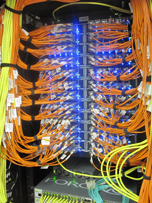
Blinky lights all aglow inside the Discover supercomputer.
In a recent post I introduced you to the supercomputer down the hall — seriously, it’s right down the hall from my office and down one flight of stairs. The machine is called Discover, and scientists at Goddard’s NASA Center for Climate Simulation use it to study climate change, weather, and other basic questions about our planet.
Discover’s component parts are spread across several rooms, connected by a high-speed data network. People can network into the system from across Goddard’s campus or the country via data superhighways. In recent weeks, Discover has turned into a construction site. The upgrade now underway will double the system’s computing capacity.
Here’s a quick tour of the project and a refresher on what a supercomputer looks like and how it works.
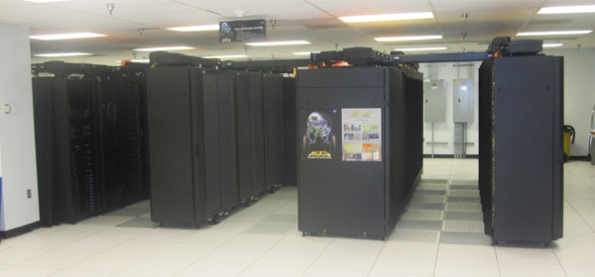
This is what Discover looks like: metal cabinets, called racks, full of shallow rectangular devices called nodes. Think of a node as the equivalent of a souped-up desktop computer. The heart of each node is a processor, or “core.” (The MacBook Pro laptop I wrote this blog on contains an Intel Core 2 Duo chip with two cores.) The four rows of 18 cabinets, or “racks,” above contain 8,256 cores, or roughly 4,000 times the processing capability of my laptop. Another room contains an additional 32 racks. These two rooms, with 50 racks of processing nodes, comprise the current Discover “cluster,” with a total of 14,968 cores.
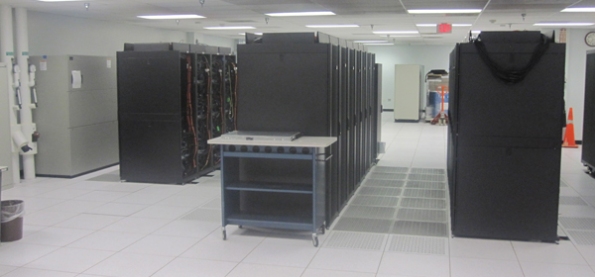
This is “Scalable Unit 7,” the newest addition to the Discover cluster. These 18 racks contain 14,400 cores — roughly the same capacity of the 50 preexisting racks of equipment. The reason is that chip manufacturers can now put more processors on the same slab of silicon. Again, back to my MacBook Pro: its chip contains two cores. Older chips in Discover contain up to four cores. Scalable Unit 7 contains nodes with Intel Xeon Westmere processors, which contain SIX cores per chip. The bottom line is you can pack more computing power in the same space. The upgrade will nearly double Discover’s capacity to 29,368 cores, with a peak speed of 320 trillion calculations per second.
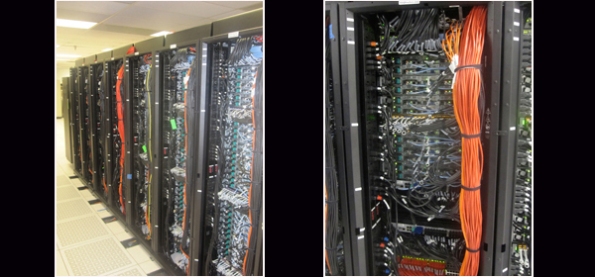
Here are the backs of the racks. You can see the nodes, connected by wire and fiber optics. Cooling fans inside the nodes blow hot air toward the backs of the cabinets. Special refrigerated cooling doors will absorb that heat and remove it using Goddard’s chilled water AC system.
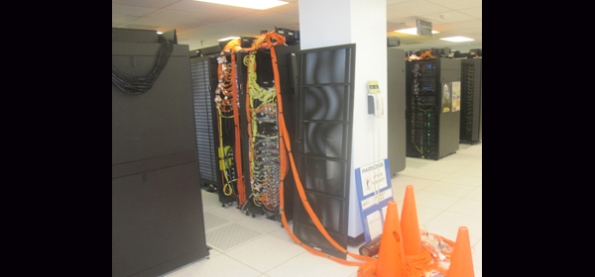
That big cable snake will connect Scalable Unit 7 to the rest of the supercomputer. The final incarnation of Discover, with nearly 30,000 cores, will require more than 5 miles of copper wire cable and 6 miles of fiber optics to connect all the components of the system. That includes 12 petabytes of mass data storage capacity, or the equivalent of 3.2 billion iTunes song downloads.
Right now, the installation is still underway. The NCCS computer technologists and researchers will put the new and improved Discover through its paces over the coming months and have it running at full capacity by the end of the year.
_____________________________________________________________________________________________________ OH AND DID I MENTION? All opinions and opinionlike objects in this blog are mine alone and NOT those of NASA or Goddard Space Flight Center. And while we’re at it, links to websites posted on this blog do not imply endorsement of those websites by NASA.
//
</p> <div><a href=”http://www.w3counter.com” mce_href=”http://www.w3counter.com”><img src=”http://w3counter.com/tracker.php?id=39986″ mce_src=”http://w3counter.com/tracker.php?id=39986″ style=”border: 0″ mce_style=”border: 0″ alt=”W3Counter” /></a></div> <p>
Bodies in motion: a computer modeling trick developed at Goddard allows us to simulate what our solar system looks like to aliens
A few years ago, a University of Maryland graduate student, Christopher Stark, crossed paths with NASA astrophysicist Marc Kuchner. “He landed in my office and asked me if I had any projects,” Kuchner recalls.
Stark needed to do some interesting and original science so he could become a professional scientist instead of a professional student; Kuchner needed help with his interesting and original research on how planets sculpt the disks of dust and gas in alien star systems, creating features like rings, gaps, and clumps.
And maybe, just maybe, by imaging those rings, gaps, and clumps in disks of dust around alien star systems, we might be able to discover planets. In other words, we might find planets by spotting their gravitational pull on their surroundings, as opposed to taking a picture of the actual planets, which is a rare and delicate trick.
http://www.youtube.com/v/BYQZRgWwXgQ?fs=1&hl=en_US
New model
Fast forward to summer 2010. Stark finishes his PhD thesis on computer modeling of dust disks around alien stars, gets a sweet job at Carnegie Institution for Science in Washington, D.C., and is the lead author on a paper describing aforementioned interesting and original science in the September 7, 2010, Astronomical Journal. Life is good!
Read the Goddard Space Flight Center press release and video for the science details. Stark and Kuchner basically simulated the dust in our own solar system and showed what it would look like to alien astronomers observing from afar. (Hint: they can see a ring-shaped collection of dust with a gap due to the influence of Neptune.)
Here, let’s talk about how Stark and Kuchner simulated dusty solar systems in the supercomputer down the hall from me.
The “debris disks” around stars contain an unimaginable number of tiny grains of dust — “dust” being tiny clots of crusty minerals and frozen vapors. Fluffy interplanetary dust bunnies, really.
As planets orbit, their gravity can induce rings and clumps in the dust. And because warm interplanetary dust radiates infrared energy, telescopes trillions of miles away can actually SEE the rings and clumps even though they can’t see the planets creating them.
Kuchner and Stark decided to build a more realistic computer simulation of dusty disks with planets. It could prove a pretty handy tool for spotting planets someday.
The problem: too many dust bunnies! Getting a computer to track the movements and interactions of so many bits of stuff is, well, practically impossible.
Ever heard of the “three body problem”? For physicists of olde like Sir Isaac Newton, calculating the motions of three gravitating bodies in free space was enough to induce cardiac arrest. Dauntingly, terrifyingly, slide-rule-breakingly hard.
“How,” Kuchner asks, “do you figure out the answer without having to figure out a billion billion billion collisions?”
Stalking dust bunnies
Tracking a billion billion billion dust bunnies is not even worth considering, even with the formidable computing resources down the hall from me at Goddard, that being the Discover supercomputer.
But Stark and Kuchner found a way. They call it the collisional grooming algorithm.
An algorithm is a precise set of mathematical rules that describes how to solve a problem. Stark and Kuchner used it to simulate 75,000 virtual dust particles and track their motions and number in response to grain-grain collisions and the gravitational tug of planets.
But what about all the other dust bunnies, the billion-billion-billion?
“We allow each single integrated particle to represent many dust grains,” Stark explains. “We scale the number of dust grains up and down to control how much dust is in the disk, even though we only actually integrate 75,000 particles.”
But let nobody leave the room thinking that approximating the behavior of 10 billion billion billion dust bunnies is easy.
At Goddard, we have a supercomputer called Discover. The thingies that do the actual data processing in a computer are called processors, and Discover presently has about 15,000 of them. That’s the number of processors in 7,500 MacBook Pro laptops like the one I used to write this blog post. Which is to say, my laptop packs an Intel Core Duo, or two processors, whereas the Discover supercomputer packs about 15,000 processors. Soon, Discover will double in capacity to nearly 30,000 processors.
To run Stark and Kuchner’s interplanetary dust bunny simulation required about 3,000 processors — the equivalent of 1,500 MacBook Pro’s — running for 24 hours!
_____________________________________________________________________________________________________
OH AND DID I MENTION? All opinions and opinionlike objects in this blog are mine alone and NOT those of NASA or Goddard Space Flight Center. And while we’re at it, links to websites posted on this blog do not imply endorsement of those websites by NASA.
//
</p> <div><a href=”http://www.w3counter.com” mce_href=”http://www.w3counter.com”><img src=”http://w3counter.com/tracker.php?id=39986″ mce_src=”http://w3counter.com/tracker.php?id=39986″ style=”border: 0″ mce_style=”border: 0″ alt=”W3Counter” /></a></div> <p>
That Was The Week That Was, August 22-27, 2010. . . A Digest of Goddard People, Science, & Media, PLUS Historical Tidbits and Our Best Stuff in the Blogpodcastotwittersphere
SUNDAY AUGUST 22: Ray Bradbury, author of The Martian Chronicles and other classics, was born this day 100 years ago in Waukegan, Illinois.
The rockets came like drums, beating in the night. The rockets came like locusts, swarming and settling in blooms of rosy smoke. And from the rockets ran men with hammers in their hands to beat the strange world into a shape that was familiar to the eye, to bludgeon away all the strangeness, their mouths fringed with nails so they resembled steel-toothed carnivores, spitting them into their swift hands as they hammered up frame cottages and scuttled over roofs with shingles to blot out the eerie stars, and fit green shades to pull against the night.
MONDAY AUGUST 23: The MODIS Image of the Day shows a plankton bloom off Greenland.
Planet pulverizers: A research team including Goddard’s Marc Kuchner finds evidence of planet-destroying collisions in another star system!
Dog days of summer: On What On Earth, bloggers Patrick Lynch and Adam Voiland of NASA’s Earth Science News Team discuss the warm and erratic summer weather.
Better luck next time: On this day in 1961, Ranger 1 launched. When the experimental satellite separated from its Agena booster stage it went into a low Earth orbit and began tumbling. The satellite re-entered Earth’s atmosphere a week later, on August 30, 1961
Awesomely: Featured in Blueshift’s Weekly Awesomeness Round Up: solar sail, sunspots, special shuttle launch, space colonies, and other highlights in space science and astronomy.
TUESDAY AUGUST 24: Goddard marks the 5-year anniversary of the Hurricane Katrina catastrophe: The Scientific Visualization Studio provides a satellite-eye view of the tempest. See a Katrina Flickr gallery by Public Affairs photo maven Rebecca Roth. Meanwhile, gogblog asks Goddard researcher Siegfried Schubert how supercomputers are improving hurricane forecasting. And Discovery News blogger Michael Reilly comments on the Goddard satellite visualization about Katrina.
This year’s model: Here’s how to build a life-size mock-up of the James Webb Space Telescope.
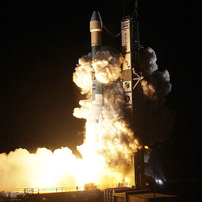 WEDNESDAY AUGUST 25: Satellite imagery featured today: dust storms in Afghanistan and Pakistan and how satellites can help archeologists preserve hidden cultural treasures.
WEDNESDAY AUGUST 25: Satellite imagery featured today: dust storms in Afghanistan and Pakistan and how satellites can help archeologists preserve hidden cultural treasures.
Koji says: Take a tour of the international observatory on the island of La Palma with NASA Blueshift blogger Koji Mukai.
Hail to the chief. . . of the Goddard Astrochemistry Laboratory, Jason Dworkin, in a new video profile.
Go Spitzer! On this day in 2003, the Space Infrared Telescope Facility (SIRTF) launched into orbit. One of the quartet of NASA Great Observatories, SIRTF was renamed the Spitzer Space Telescope and continues to push the frontiers of space-based astronomy.
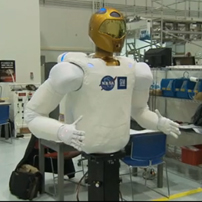 THURSDAY AUGUST 26: Earth Observatory spotlights satellite view of fires raging in South America.
THURSDAY AUGUST 26: Earth Observatory spotlights satellite view of fires raging in South America.
FRIDAY AUGUST 27: On this day in 1962, Mariner 2 left for Venus, to become the first spaceship from Earth to visit another planet.
Space rocks: NASA and U2 released a commemorative video highlighting a year’s worth of collaboration in space and on the Irish rock band’s 360 Degree tour.
I, Robonaut! NASA’s humanoid astronaut buddy is being prepared for its history making launch to the International Space Station on STS-133.
_____________________________________________________________________________________________________
OH AND DID I MENTION? All opinions and opinionlike objects in this blog are mine alone and NOT those of NASA or Goddard Space Flight Center. And while we’re at it, links to websites posted on this blog do not imply endorsement of those websites by NASA.
//
</p> <div><a href=”http://www.w3counter.com” mce_href=”http://www.w3counter.com”><img src=”http://w3counter.com/tracker.php?id=39986″ mce_src=”http://w3counter.com/tracker.php?id=39986″ style=”border: 0″ mce_style=”border: 0″ alt=”W3Counter” /></a></div> <p>
Katrina +5: Where is hurricane science now and where is it going? At Goddard, researchers are betting on supercomputing to give us an edge over nature's deadliest storms
Since the notorious 2005 hurricane season that included Hurricane Katrina, “there have been tremendous advances in high-resolution modeling of storms,” according to GMAO scientist Siegfried Schubert.
Schubert says that researchers have reached new heights in detailed weather and climate simulation using Goddard’s Discover supercomputer. The star of the show is the Goddard Earth Observing System Model, Version 5 (GEOS-5).
GEOS-5 combines theoretical simulation of Earth’s coupled ocean-atmosphere system and real data from Goddard’s fleet of Earth-observing satellites. Clouds form and billow; storms evolve from moisture and heat; hurricanes scud across ocean basins.
In a recent record for lifelike computer simulation of Earth’s storm factory, GEOS-5 reproduced details as small as 14 kilometers (about 9 miles). That’s a smaller footprint than many thunderstorms.
The model was able to simulate important structures of hurricanes, such as the sharply defined inner “eye wall” and clusters of convective clouds that are part of the storm’s plumbing system.
GMAO researcher William Putman re-ran the 2005 tropical storm seasons using GEOS-5, an exercise known as “hindcasting.” The sea surface temperature drove, or “forced,” the process, just as in real life.
The GEOS-5 model roughly reproduced the actual number of tropical storms in 2005. That year, the Atlantic basin spawned 28 tropical storms, 15 hurricanes, and 7 “major” hurricanes (Category 3 or higher).
What does this mean for you and me?
With continuing advances in both the power of supercomputers and more accurate models, the heirs to GEOS-5 should be able to produce decent seasonal forecasts. This means predicting how many storms will form, how many could be major storms.
Further on, models that account for large-scale patterns of circulation in the ocean and atmosphere could even help forecast the number of landfalling storms.
With such a forecasts, regions would at least have the option of preparing more effectively.
Check out the special feature on Katrina on the NASA website.
Watch, “Katrina Retrospective: 5 years After the Storm” below for a fascinating exploration of Hurricane Katrina from the perspective of NASA’s fleet of satellites:
_____________________________________________________________________________________________________ OH AND DID I MENTION? All opinions and opinionlike objects in this blog are mine alone and NOT those of NASA or Goddard Space Flight Center. And while we’re at it, links to websites posted on this blog do not imply endorsement of those websites by NASA.
//
</p> <div><a href=”http://www.w3counter.com” mce_href=”http://www.w3counter.com”><img src=”http://w3counter.com/tracker.php?id=39986″ mce_src=”http://w3counter.com/tracker.php?id=39986″ style=”border: 0″ mce_style=”border: 0″ alt=”W3Counter” /></a></div> <p>
